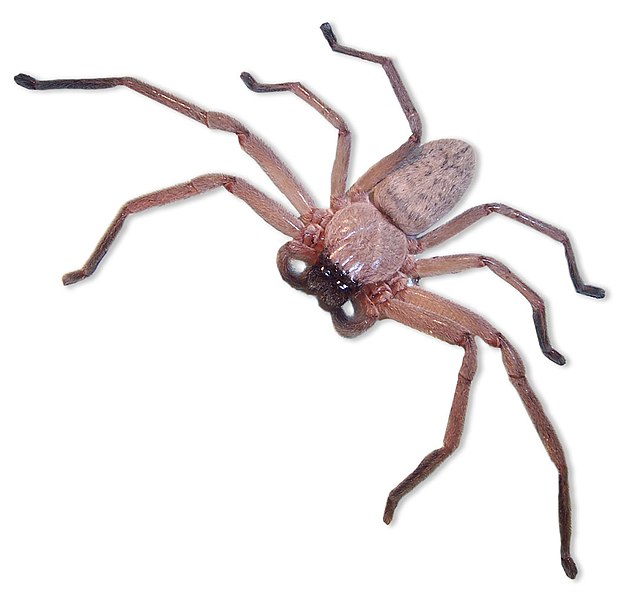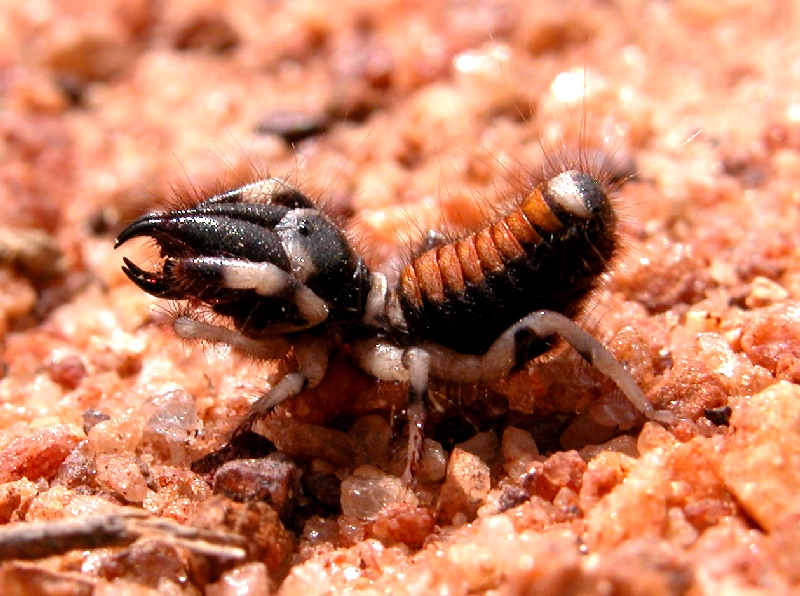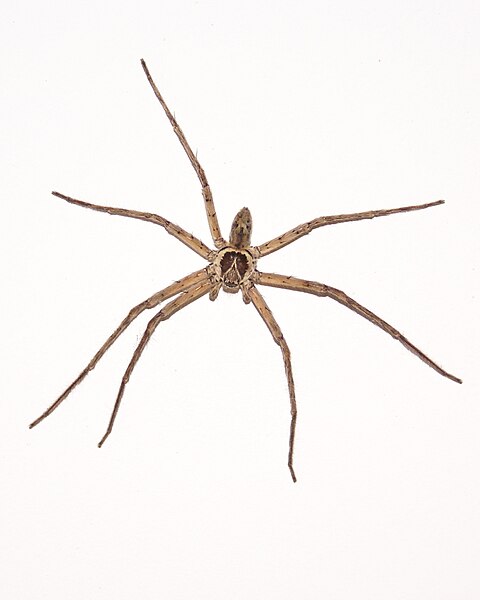The Terrestrial, Purple-Pincher or Caribbean Hermit Crab (Coenobita clypeatus) makes an endearing pet. However, it may in a sense be “too hardy” for its own good. For example, crabs may live for years even when denied salt (marine) water and other basic needs, giving owners the false impression that all is well. Read More »
Category Archives: Insects
Feed SubscriptionHunting the Huntsman – Keeping the Giant Crab or Huntsman Spider – Part 2
 In Part I of this article I talked a bit about collecting (or trying to collect!) the Huntsman Spider, Heteropoda venatoria, in a most unlikely setting. Usually purchased as a “curiosity”, the Huntsman often surprises its new owners with a range of interesting behaviors – if you thought that spider pets were limited to tarantulas, please consider this fascinating alternative!
In Part I of this article I talked a bit about collecting (or trying to collect!) the Huntsman Spider, Heteropoda venatoria, in a most unlikely setting. Usually purchased as a “curiosity”, the Huntsman often surprises its new owners with a range of interesting behaviors – if you thought that spider pets were limited to tarantulas, please consider this fascinating alternative!
Caution: Although Huntsman Spiders are not considered to be dangerously venomous, they are fast and aggressive, and will not hesitate to bite. We know little about spider venom, and the possibility of an allergic reaction must be considered (central nervous system reactions have been reported on rare occasions)….please do not touch any spider with bare hands.
Natural History
The Huntsman Spider likely originated in southern India and Sri Lanka, but is now well-established in warm regions worldwide (including Florida). They frequently enter buildings, where they sometimes welcomed for their roach-catching abilities.
The alternate name, Giant Crab Spider, took hold because these spiders hold the first 2 pairs of legs spread-out like a crab on guard. Huntsman Spiders build no webs, but rather run down their prey, and are quite ravenous. I’ve observed youngsters being dragged about by roaches three times their size, and adults sometimes catch lizards and small bats.
Huntsman Spiders are entirely arboreal and adapted to living upon flat surfaces, such as walls and tree trunks, as opposed to branches.
Huntsman Terrariums
In captivity, they take readily to cork bark and will climb terrarium glass as well. Position cork bark slabs near the glass, so that the spiders will remain visible when using the reverse side of the bark as a shelter.
While arboreal tarantulas (i.e. Pink-toed Tarantulas, Avicularia spp.) do well in standard aquariums turned on end to provide additional height, I hesitate to recommend such for Huntsman Spiders – opening the screen cover leaves a wide area available for escape. I much prefer a “tall or high style” aquarium, with the cover is on top. Alternatively, a Faunarium turned on its end might work, as the access door is small and should limit escapes.
Heat and Humidity
Huntsman Spiders favor warm, humid habitats, and should be maintained at 77-85 F and provided daily misting and a moisture-retaining substrate.
Diet
Huntsmans take nearly any insect prey available, but particularly favor roaches. Wild caught moths, katydids, beetles and grasshoppers should also be provided whenever possible.
Breeding
Male Huntsman Spiders are smaller and thinner than females, and their carapace bears darker markings. When ready to breed, males cease feeding and develop noticeably swollen pedipalps (leg-like structures bearing sperm packets). They wander about in search of females to mate with (and, usually, to be consumed by!). I’ve had breeding males escape with their lives, but none have survived for long afterwards.
The female carries her uniquely flattened egg case below her body. The young stay on her for a short time, and then disperse. If you are raising this species, be sure to cover the terrarium’s screening with an extra layer of mosquito netting, lest the hatchlings escape – a colony established in the home is not to everyone’s liking!
Further Reading
Huntsman and other spiders produce a range of sounds. An interesting article on this topic, which includes photos of males in breeding condition, is posted here.
A video showing this species’ speed and hunting style is posted
Huntsman Spider image referenced from wikipedia and originally posted by Ed g2s and Saperaud
Windscorpions (Camel Spiders, Sun Scorpions) – the Fiercest Arachnids?

Range and Reputation
The world’s 1,000+ Windscorpion species favor deserts and other warm, arid habitats. They are absent from Australia but otherwise widespread…a number dwell in Florida and the American Southwest. They are among the most active of Arachnids – and their appetites are insatiable.
When out by day, Windscorpions stay to the shadows…their habit of following people, in order to stay shaded, has earned them a quite bad reputation in North Africa. However, while Windscorpions do not actively chase people, their huge, ragged jaws can deliver painful bites, and they should only be handled with tongs.
Keeping Windscorpions
Success in keeping these little-studied invertebrates has been mixed at best. Several species appear regularly in the trade (i.e. Eremobates spp.), but none can be considered easy captives.
 Windscorpions must be kept dry, and they need a great deal of room – more than twice that of similarly-sized scorpions and spiders. A secure, undisturbed environment, stocked with artificial caves and cork bark retreats, is essential A sandy substrate, into which some species will burrow, will also help them to feel at home. Temperature requirements vary by species, but an ambient of 85 F with a warmer area of 92-95 F will suffice for most.
Windscorpions must be kept dry, and they need a great deal of room – more than twice that of similarly-sized scorpions and spiders. A secure, undisturbed environment, stocked with artificial caves and cork bark retreats, is essential A sandy substrate, into which some species will burrow, will also help them to feel at home. Temperature requirements vary by species, but an ambient of 85 F with a warmer area of 92-95 F will suffice for most.
Fast Metabolisms
Windscorpion appetites are huge – no once per week feeding for these beasts! Instead, experiment with every-other-day or even daily feedings, providing all they will take. As we know little of their nutritional requirements, vary the diet as much as possible…crickets, roaches, sow bugs, waxworms and wild-caught moths, grasshoppers and other invertebrates will all be eagerly accepted.
You can also try tong-feeding them canned invertebrates (one look at their other-worldly jaws will convince you of the wisdom of using feeding tongs)!
Folks working with Windscorpions have a real opportunity to contribute to what little we know about these most unusual creatures.
Further Reading
Tailless Whipscorpions are equally odd relatives of the Windscorpions, and easier to keep in captivity. To learn more, please see Tailless Whipscorpions – the Weirdest Invertebrates?
You can check out the imposing jaws of a Windscorpion in this video.
Wind Scorpion image referenced from wikipedia and originally posted by Vijaybarve
Hunting the Huntsman – Keeping the Giant Crab, or Huntsman Spider – Part 1
As a boy, my favorite exotic animal collecting site was, of all places, the loading dock of the local A&P Supermarket. Raymond Ditmars and other famous city-born naturalists had taken this route, and so I followed. The store was not far from the Bronx’s Hunts Point Market, where trucks from all over delivered fresh produce. Hidden within the produce crates were the creatures I sought – tree frogs, spiders, lizards, insects and such (I once narrowly missed a Mouse Opossum). All large spiders were called “Banana Spiders”…one, the Giant Crab or Huntsman Spider (Heteropoda venatoria), appeared on occasion but was always too fast for me. I became obsessed with this beast, whose leg span approached 6 inches, but, try as I might, I remained crab spider-less.
Meeting Both a Long-Lost Spider and Entomologist

The spiders were faster than I remembered (and I was slower!)…those I captured had mainly fallen into places from which they could not escape. They proved surprisingly easy to breed and, once set up in our exhibit area, were very popular with our visitors.
I took a specimen to the American Museum of Natural History, where it was identified as Heteropoda venatoria. Amazingly, the woman who identified the spider for me was famed invertebrate specialist Alice Gray…while speaking, we discovered that it was she who had answered my mantis rearing questions when I called the museum as a boy, 25 years earlier!
Captive Care
These impressive spiders occasionally appear on the price lists of Florida-based reptile dealers, and they are quite inexpensive. If a few guidelines are followed, they make fascinating, active terrarium inhabitants, and breed readily. Once their amazing speed in hunting is seen in action, even die-hard tarantula fans cannot resist them!
I’ll cover the natural history and captive care of Huntsman Spiders in Part II of this article.
Further Reading
An interesting article on this spider’s life cycle is posted at on the website of the Cambridge Entomological Society.
Male Huntsman Spider image referenced from wikipedia and originally posted by B. Navez
Snake and Spider Fears and Phobias – Instinctive or Learned
A great many people are fearful of snakes and spiders, often to a seemingly unreasonable degree, and without any prior negative experiences. Researchers have long sought to discover if people possess an inborn, instinctual aversion to these creatures, or if learning is involved.
Living Near Venomous Animals
 My own view has always been that it makes sense for people living in the tropics to avoid all snakes and spiders, and I’ve observed that this lesson is taught to children early in life in many places.
My own view has always been that it makes sense for people living in the tropics to avoid all snakes and spiders, and I’ve observed that this lesson is taught to children early in life in many places.
There are still over 10,0000 snakebite deaths yearly worldwide, and in areas of high species diversity it is nearly impossible to distinguish all venomous from harmless species (in recent times, 2 renowned herpetologists were killed by snakes not know to be venomous). On my first research project in Costa Rica, I foolishly believed that I would be able to identify many of the snakes and spiders I might encounter. My first nighttime walk through overgrown scrub quickly taught me otherwise!
Another important point to bear in mind is that animals, especially snakes and spiders, are drawn to homes and gardens due to an unnaturally high density of prey (rodents, insects) and in search of shelter. During the dry season in Venezuela, I collected numerous treefrogs, bats and spiders indoors.
Snakes and Primate Evolution
So, based on my experiences, I leaned toward a learning-based explanation. However, recent work at UC Davis has revealed a possible evolutionary explanation to snake aversion among monkeys and, it is theorized, humans.
Fossil and DNA evidence indicates that large snakes may have been among the first serious predators of modern mammals, and were possibly the driving force behind the development of keen eyesight in Primates. The evolution of the Primate vision system seems linked very closely to fear and vigilance receptors in the brain. As Primates became better at spotting snakes, snakes developed more effective camouflage, and so on.
On Madagascar, where large snakes are absent, Primates (lemurs) have not developed the excellent vision possessed by their relatives on mainland Africa.
Most primates do indeed react with “instinctive” fear upon seeing a snake for the first time. However, I have noticed that a great many creatures, ranging from rodents to elephants, treat novel objects with caution, however harmless they might be.
Research Involving People
Experiments involving people have yielded mixed results. Studies conducted at the Universities of Virginia and Queensland has shown that snakes and spiders draw far more attention from human observers than do other potentially deadly animals or objects.
But many of us have (or, at least, I have!) seen toddlers squeal with delight when presented with a spider or snake…yet they will become quite scared if they see an adult express fear.
One thing I’ve noticed is that snakes and spiders have “odd shapes” (except to herpers!)…I wonder if this draws attention; and anything that moves suddenly can startle an observer, especially if it is new to that person.
Teach Them Early
It seems we must wait awhile for answers that may help people overcome their fears and view our cold-blooded friends more reasonably. Until then, please do your part to introduce the next generation to nature early…the little guy pictured here will have no excuses for disliking herps – I’m starting him out on amphibians, and working my way up the “fear scale”!
Further Reading
You can read more about some of the research mentioned here.
 That Reptile Blog – Reptile, Amphibian and Exotic Pet Care and Information
That Reptile Blog – Reptile, Amphibian and Exotic Pet Care and Information
